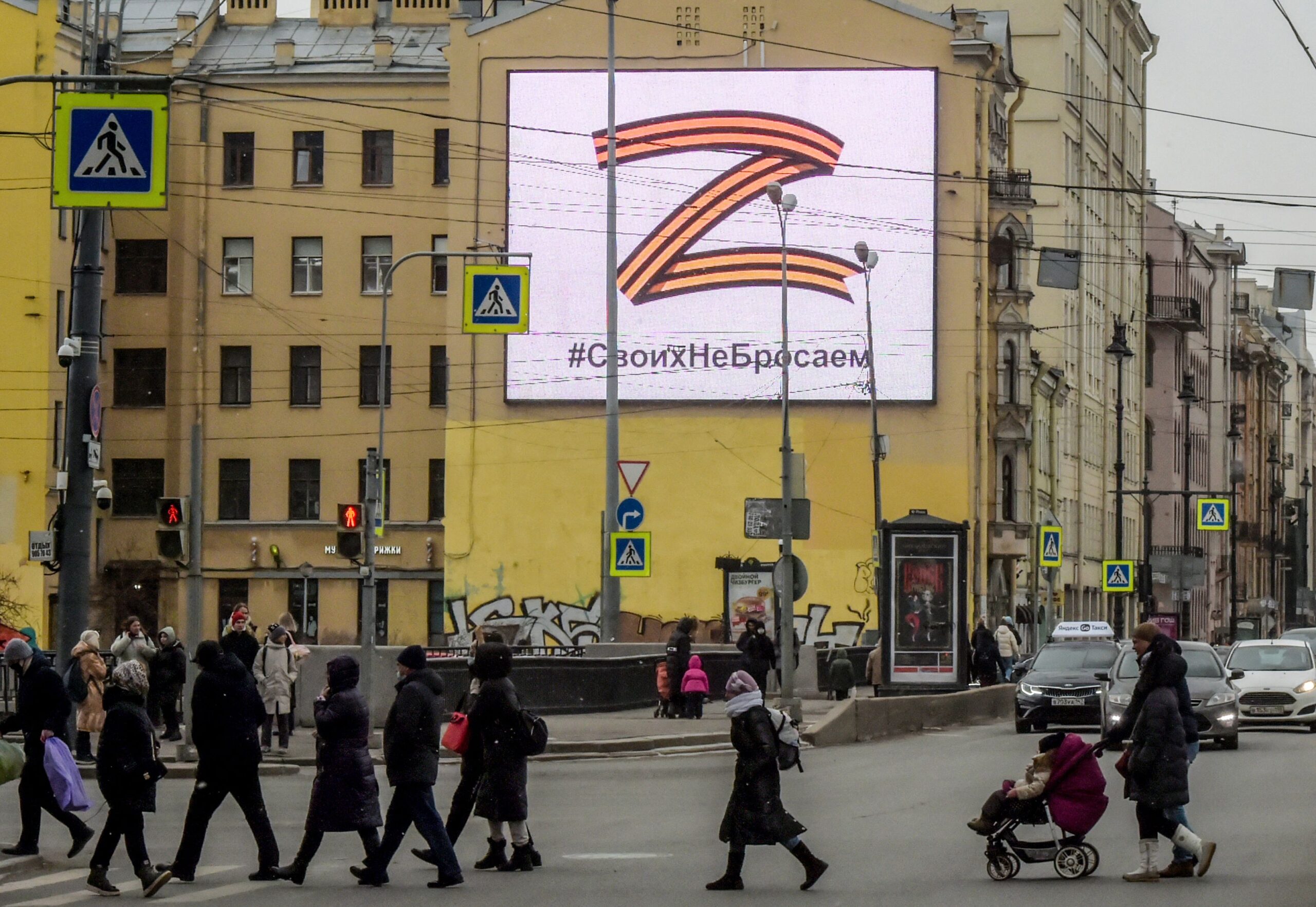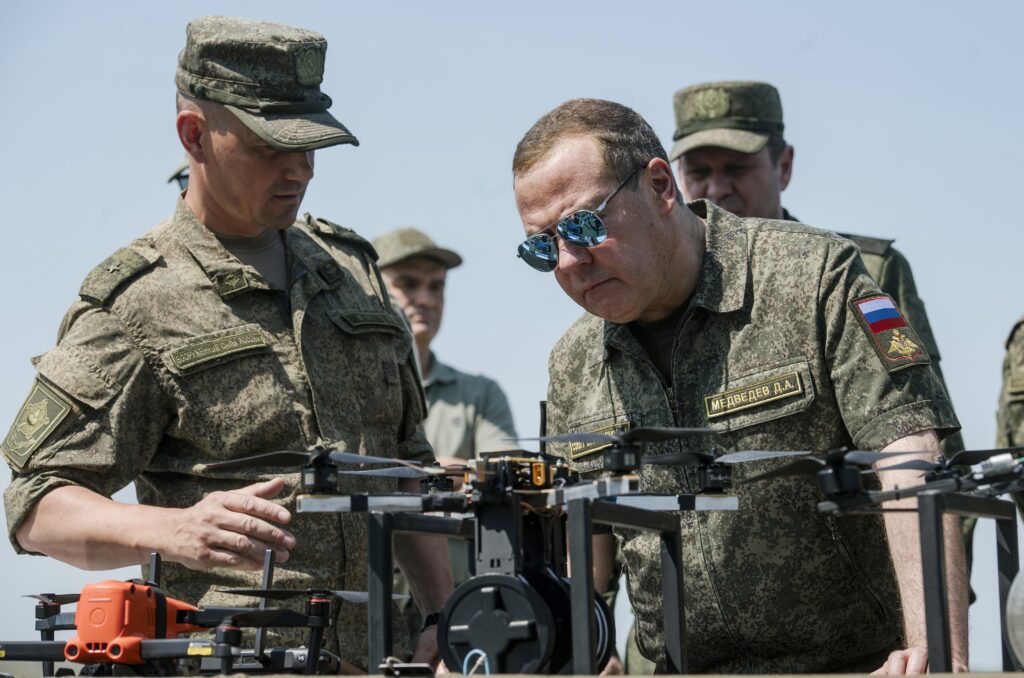The Russian leadership and its propaganda machine have been unable to offer the citizens of Russia any coherent explanation for the invasion of Ukraine. According to the Athena sociological project, the only more or less understandable explanation to Russians for what is happening is the protection of the DPR and LPR (32% of respondents say). The same survey found that 27% do not know how to answer a question about the goals of the «special operation» (and this is the second most popular answer).
Meanwhile, people are invited to rally under the mysterious symbol Z, the meaning of which no one understands. Some Kremlin strategists are not all happy with the Z; some even anonymously criticize it.
Under the Z sign
Who identifies with this Z and why? After the invasion of Ukraine, Russia’s leading sociological services reported an increase in the ratings of President Putin (+10.2% according to VTsIOM) and other institutions of power. Radio Liberty published the results of a study where 71% of Russians are allegedly proud of the war. It is hard to rely on these figures, if only because a criminal article has recently appeared in Russia potentially punishing anything seen to be «discrediting the Armed Forces.» Judging by the first cases, one can fall under it even for simple calls for peace. In such circumstances, citizens are unlikely to be honest about their attitude to the «special operation”/war. They will either refuse to participate in the poll or, just in case, will speak out in support of any actions of the Kremlin.
But as the propaganda machine began to brand the invasion as «Operation Z» Russian state news outlets heavily pushed a notion of emphatic popular support. In Russian cities, flash mobs proliferated. They adopted the letter Z, as a symbol of solidarity for Russian troops and loyalty to the Russian authorities. Schoolchildren and kindergarteners line up in the letter Z. State employees and officials publish photos with Z-posters. Z-motor races were held in several regions. On the surface, it looks like a powerful upsurge of patriotism, and a show of grassroots support for government initiatives. But that is to miss the point.
The letter came from the white Zs placed on Russian military equipment by the troops themselves (these were also marked with other letters, such as V and O), and, according to military experts, they denoted a military district or direction of attack. However, the PR people of the Ministry of Defense liked the letter. Sergei Shoigu, head of the ministry, has had a keen eye for PR since the 1990s, when he headed the Ministry of Emergency Situations. Back then, he managed to build an image as a rescuer of the country, and people considered his department one of the most effective. In the Ministry of Defense, Shoigu did not change his approach. The military began to hold spectacular events such as a tank biathlon, beautifully filmed exercises, and even participating in hostilities in Syria with a tailored TV-image. During the operation in Crimea in 2014, the Ministry of Defense launched the «polite people» brand. Its essence was that the Russian army does not even need to fight to achieve any goals; the enemy surrenders from its mere presence. The state channel Russia Today, which also knows a thing or two about patriotic PR, helped the Ministry of Defense with the design and decoration of merchandise, such as T-shirts and bags. After that, Z began to be placed on billboards — first without slogans, then with them — «Z for Victory», «Z for peace», «Cheering for OurZ». Quite quickly, Z turned into the colors of the St. George ribbon, the usual symbol of victory in the Great Patriotic War (and after 2014 — evidence of general support for the authorities).
So far, there has been no clear explanation why the campaign to support the actions of the authorities needed to use the Latin letter. Most likely, one of the reasons lies in the fact that the president kept the decision to launch the invasion a secret from government officials until the very end. It is very difficult to explain the choice of the letter Z and its use in a mobilization and PR campaign otherwise. The «Z-campaign» looks strange and ill-conceived when Russian politicians claim they are fighting for the protection of the «Russian world». It turns out that the Russian world is protected under a Western letter. Worse still, the Z inconveniently also at the beginning of the name of Ukrainian President Volodymyr Zelensky. Even Kremlin political technologists criticize the new ultra-patriotic brand behind their backs for its ideological senselessness. Calling the letter Z a «symbol» is in itself highly problematic; a symbol has a meaning, and Z has none. This is a pure simulacrum — a sign without a referent. According to its creators, the letter should have looked like unifying symbols — the Pacific sign, a white ribbon, a swastika, an LGBT sign. People «identify» themselves by indicating to others what views they hold. Unlike the same St. George ribbon, which the Russians use a lot, Z has not yet gained popularity. It is mainly placed on their cars by officials or state employees. In the case of the latter, the question of whether this step is voluntary remains open.
Imitation of support
The authorities suggest citizens adopt a randomly selected letter and consider this is now the current symbol of a Russian brand. But there is nothing behind Z; there is an ideological void. Russian government does not explain to citizens and even to itself what it is doing and why. Is it for fighting or conducting a «special operation»? Is it set on preventing Ukraine from attacking the DPR and LPR, or from developing nuclear weapons? Is Kremlin aiming to depose President Zelensky or does it consider him a legitimate ruler?
At the same time, what is happening is extremely serious. A real war is raging; civilians are dying; Ukrainian and Russian soldiers are being killed; Ukrainian cities are being destroyed. The Russian economy is suffering due to anti-war sanctions; accordingly, the well-being of Russian citizens is also under threat. Many of them will fall into the pit of poverty. But the Kremlin did not even try to provide an ideological justification for both the war in Ukraine and the sanctions war that followed. Instead, citizens are simply given a template with a letter Z.
Due to how the semantic content of this symbol is not clear, it cannot have any broad grassroots support. Some Russians loyal to the authorities may sincerely put Z on avatars in social networks or stick the letter on their cars. But is just as vacuous as when putting on, for example, a T-shirt bearing an image of the president, or the inscription «Don’t make my Iskanders laugh.» For these people, the idea of Z is simple and understandable: they said at the top that it is now the main symbol of the country, so we believe and salute it. For them, the letter is a simple badge of loyalty. Absolutely any sign lowered from the Kremlin could take its place. Such people in Russia are not the vast majority. Therefore, the Kremlin has to imitate popular support, mobilizing people financially dependent on the government, state employees and municipal officials. They take pictures of posters with Z, hold car races and flash mobs, force children to line up in Z-order in schools and kindergartens, come to rallies in support of the authorities during working hours. The falsity of these mobilization actions is obvious even to their participants: the events are based on coercion and blackmail (if you don’t come to a flash mob or a rally, you will be noted) or simply bribery. This only further discredits the Z brand.
Kremlin brand management
The «Z-campaign» itself is very similar to the result of any public procurement in the field of marketing and branding, which almost always ends in a story of corruption. As a rule, it happens like this: a large government agency, region or city puts up for auction a contract to develop a logo or brand book for itself or its event. The right company wins the competition, presents a some cheap logo for reporting, and the money goes to the right pockets. The effectiveness of this marketing product is usually not measured, though it is regularly placed on billboards and posters. At the state level, this approach is used for the first time. Perhaps Russia has become the first state that, at a critical moment in its existence, is trying to position itself with the help of an empty-shell brand.
The attempt of total mobilization of people in the style of Z testifies to the impasse into which the quasi-ideology of the Kremlin has entered. Previously, citizens were asked to give up active participation in politics in exchange for the so-called Putin stability. After Crimea, the Russian authorities could «sell» new shades of ideology to most citizens: almost nothing happened to stability, but Russia regained its «sacred place», and you can have a good rest in Crimea. But the «Donbas project» in 2014−2015 failed to advance. One of the reasons was its indistinctness. People did not understand why Russia needed this foreign territory. Then the authorities realized this and retreated. Now Putin clearly does not want to listen even to his inner circle. At a meeting of the Security Council before the invasion, Security Council Secretary Nikolai Patrushev and SVR head Sergei Naryshkin spoke in favor of continuing negotiations. Naryshkin was harshly reprimanded by Putin. He was then forced to speak out in support of the recognition of the DPR and LPR. After the invasion, influential oligarchs Roman Abramovich and Oleg Deripaska spoke out in support of a speedy resolution of the issue by peaceful means. The President did not take their position into account either. Even less important for him is the opinion of private citizens.
Propaganda cannot package Putin’s aspirations like his confrontation with the West into an ideological product, because there is no rational sense in these actions. This is an ideological dead end. So people get the same irrational Z as an explanation.
There is good news in Russia’s use of the empty brand. Over the next few months, the standard of living of citizens will fall sharply (it has already sunk quite a lot). Many Russians believe the government will cope with the crisis, sanctions are not so terrible, and if anything, China will help. Still, the true scale of the problems will become apparent to them later. And the deterioration of the social and economic situation always leads to a drop in the rating of the authorities (suffice to recall the pension reform of 2018). At some point, the Russians will begin to ask the president and the government: «What, in fact, are we suffering for?» The answer «Because of Z» is unlikely to suffice.










